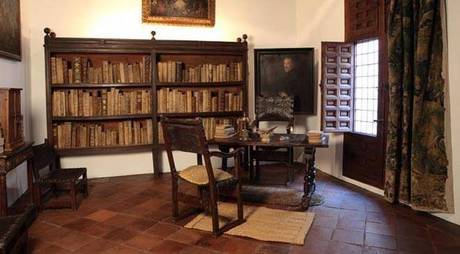Lope de Vega Museum
The Lope de Vega House Museum can be found in the Literary Quarter, in the building where the writer and his family lived between 1610 and 1635. The aim was to recreate an environment in which Lope's presence could be felt, evoking daily life during the Golden Age with areas such as the dais, study, chapel, bedrooms, garden and vegetable plot. Created in 1935, the museum contains art works, books, household items and 17th century furniture from various museums and institutions.
The building is a two-floor Castilian home made of brick that is typical of the time period. The museum strives to keep the interior of the house as it would have been when the poet lived there during the 17th century and exhibits some of Lope’s personal belongings. The house consists of several family bedrooms, the kitchen, garden, oratory complete with pulpit, and study, where the museum’s prize possessions are kept, three original manuscripts of Lope’s plays. The famous writer lived in the house from 1610 to 1635 and became a priest after the death of his second wife despite his philandering nature.
The house once occupied by Lope de Vega stands in a quiet little lane in the "literary quarter" of Madrid, round the Calle del Prado, the Plaza de Santa Ana and the Calle de Atocha. The great dramatist and poet, creator of the 17th C. Spanish comedia, settled here in 1610. The rooms of the house and the little garden, in which Lope de Vega and his family lived, worked and took their ease, are now open to the public as a museum, and offer an appealing impression of everyday life in Madrid in Spain's Golden Age.
Félix Lope de Vega y Carpio (1562-1635) was Spain's greatest playwright (he's often called "the Shakespeare of Spanish literature") and his two-story brick town house uphill from the Paseo del Prado is located on a street named after his contemporary and adversary Cervantes, the country's most famous novelist.
Lope de Vega started writing at age 12 and completed close to 2000 plays (a number never beaten by anyone else). He was a rather controversial figure in his time, having been banished from Madrid for eight years for having written insulting poems about his former girlfriend (the daughter of an important businessman), who had abandoned him for a wealthy lover.
He then lived in this building from 1610 until his death in 1635, and a visit to this now house-museum provides an overview of everyday life during Spain's Golden Age in the 17th century. It is a trip back in time, with the rooms displaying period furniture among other interesting features such as whale-oil lamps and pans used to warm the bedsheets.
The delightful gardens in the back contain the same ancient fruit trees described in the writer's journals, as well as an interesting well, and should not be missed.
Over the entrance, look for an inscription in Latin, "parva propia magna, magna aliena parva" that translates approximately to "what little I have is much, what much others have is little". An informative tour (also available in English) makes a visit much more interesting.
The museum is open from 9:30AM – 1:30PM Tuesday through Friday, 10:00AM – 1:30PM on Saturday and closed Sunday and Monday. The museum also closes the entire month of August and all of Holy Week. Entrance is free.
Madrid has been the inspiration for some of Spanish best literature. Madrid’s literary district is a beautifully preserved XVII century area where strolling along Huertas’ street, you will remember writers like Quevedo and Góngora. Cervantes lived in that area, and we can visit near by the beautifully preserved house and home of the great Lope de Vega. Then, by streets that bring to us memories of Echegaray and Moratín and by Plaza de Jacinto Benavente, 1922 literature Nobel Price, we will reach Plaza Mayor, immortalized in his novels by Benito Perez Galdós. You can get there via flight to Madrid.


